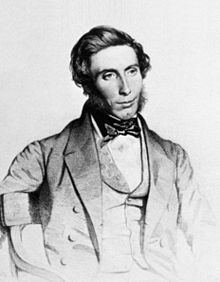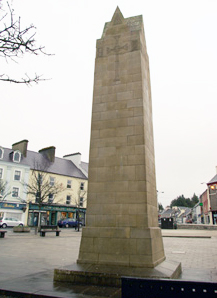Memorials to the Four Masters
Lately I have been looking at memorials to the Four Masters . To date I have found those listed below but there may be more …………………………
1: Memorial Celtic Cross opposite the Mater Misericordiae Hospital erected in 1876[1].
According to the author B. Mac Giolla Phadraig no memorial was erected to the Four Masters until the memorial cross standing in the little park at the corner of Berkeley Road and Eccles Street was put up in 1876.

The movement to have the cross erected was initiated by Sir William Robert Wilde (father of the playwright Oscar Wilde) in a letter to The Nation in 1871. After enumerating all the chief monuments and statues erected in this country, he complained that nothing had been done to commemorate the memory of the Four Franciscans ( in fact only Brother Michael O Clery was a Franciscan-the other three were laymen, trained genealogists and chroniclers specially chosen by him)[2] who had written the famous Annals. He wanted, he said to erase the rebuke conveyed in the following lines of J. F O’Donnell in his Memories of the Irish Franciscans;
“No cromlech, cairn, or monument, Commemorates,
the mighty Four;
They sleep unhonoured; their great task,
Inspired by loving faith, is o’er;
But the brave land they served so well
Asks; Shall it thus be evermore?
A Celtic cross, around whose arms
Shamrocks in many a cluster fall,
Should plead for them, and lift its head
‘Twixt blasted tower and shattered wall,
Where beats the sea against the base
Of gray and ruined Donegal.”
Sir William says in his letter that he tried to have a small tablet inserted into the wall of the ruined Convent of Donegal to indicate that in its vicinity the Annals were written, but that he got very little local support for the idea.
He then continues: “My idea is to erect within the precincts of the ruined Monastery of Donegal a monumental monolithic cross of the most durable of Irish material, sculptured by the most educated Irish art, emblematic in device and upon the model of the best Irish monument of that description, inscribed in the Irish, Latin and English languages and if possible in the Ogham character too”
Description of the cross:

It is of Dungannon stone measuring 9 ft 3in in height and standing on a stepped platform of the same material 3 ft high.
The cross is modelled on the ancient unornamented cross of Kilree (near Kells, Co Kilkenny) and is of the same proportions. The interlaced designs on the panels of the front are copied from the large cross of Monasterboice. The crosses of Tuam and Kilclispeen (near Carrick-on-Suir) supply designs for the panels on the sides and back. The bosses within the circle are from the shrine of St Mainchin of Lemanahan in Offaly.
The inscriptions in Latin, English and Irish are as follows:
Right side of base
Quatuor Pracelaris/ Magistris Ex Franciscali Ordine/ Michaeli O Clery/ Fearfaso O Malchonaire/ Cucogri O Clery/ Cocogri O Duigenan/ Qui Magnis/ Laboribus Exantlatis/ Qestuante in Catholicam /Fidem Hostium/ Odio Ac Furore /Veteres Hiberniae / Annales Ab /Interitu /Vindicarunt Tanti in Patram Benefich /Ne Memoriam Deleret/ Dies /Clerus Polulusque/ Aere Conlato /CommunI Concenso Dedicarunt/ Anne R.S. MDCCCLXXVI
Back of base
To the Four Illustrious Masters/ Of the Franciscan Order /Michael O’Clery/ Fearfeasa O’Mulconry/ Peregrine O’Clery/ Peregrine O’Duigenan/ By whose untiring labours /At a time when hatred and persecution /Raged against The Catholic Religion/ The Ancient Annals of Ireland were saved/ From destruction /Grateful for such a noble achievement/ And/To perpetuate its memory/ The Clergy and People by public subscription/Erected this Cross/ A.D. 1876
Left of base
Droit to Mhichel O Cleirigh[1] d’Fherfesa O Maelconaire do Choincoicrice O Cleirigh ocus do Choincoicrice O Duibhgennain na ceithre sencaidi foghlamta, airrdirci le’r ocus diar tocbad in cros so
Front of base
Annals Commenced 1632 Finished 1636
Note from MC: The monument has now stood in its present site for 135 years and I would hazard a guess that most people who pass it have no idea of its significance.
[1] Sadly I don’t have Irish alphabet letters on my word processor to do the inscription justice!
[1] Dublin and the Four Masters, B MacGiolla Phadraig, Dublin Historical Record, Vol VI, No2, March-May 1944
[2] Madeleine Cleary based on research
Pulpit St Eunan’s Cathedral, Letterkenny 1900[1]

In St Eunan’s Cathedral Letterkenny is the pulpit of the Four Masters. On it are statues in Carrera marble of five masters and also of the four evangelists and the prophet Isaiah. There is a fifth name written beneath the block of four in the Killiney copy of the Annals – Conaire O Clery a brother of Michael is followed by Bernardine Clery (another brother of Michael baptised Maolmhuire) and also two friars, uncle and nephew bother named Muiris Ulltach. Ultach was a second name sometimes used by the O Duinnshleibhe (Dunleavey) family. Dunleavy was also the maiden name of Michael O Clery’s mother Honora Ultach. The historical enterprise was largely a joint family undertaking. John Colgan coined the name the Annals of the Four Masters although he was aware that more than four had worked on them, because (he said) it was an easy and a fair way to refer to the different writers of the part of the Annals he was most interested in, without having to distinguish between them.
The pulpit in St Eunan’s cathedral sculptured in marbles from Connemara and Middleton in Ireland and from Sicily and Carrara in Italy, was paid for principally by the national teachers of County Donegal and it came from the workshop of James Pearse. James Pearse- father of Patrick and Willie Pearse – was an ecclesiastical and architectural sculptor at 27 Great Brunswick Street (now Pearse Street) Dublin. The Franciscan Library has a letter from Patrick Pearse dated 27/4/1900 written in the name of his father. The letter read:
“ I am about to carve figures of the Four Masters for a pulpit for Letterkenny cathedral, and Mr W G Doolin M.A., Architect, suggests that, as the chief of the 4 Masters, Michael Clery , was a Franciscan Lay Brother, you may be able to give me some authority for their dress either in the way of a print or otherwise. Of course the other 3 Masters were laymen and it is their dress that is the difficulty”.
In May 1900 another letter on behalf of James Pearse acknowledged the Franciscan cloak which had been sent to help in the modelling of the statue of Brother Mícheál O Cléirigh. James Pearse died in September 1900 and Patrick and Willie took over the business until its closure in 1910. This means that in all probability both men worked on the pulpit. The Cathedral opened in 1901.
References
[1] Patrick Pearse and the Four (or Five) Masters – Ignatius Fennessy OFM
Obelisk in the Diamond, Donegal Town 1938[1]

This four-sided obelisk/memorial was erected in 1938. It has cruciform-plan capping/finials to top with gabled-triangular projection to the centre of each face. It is constructed of ashlar sandstone and set on ashlar sandstone plinth with chamfered ashlar sandstone coping over. It is inscribed with names of the authors of the Annals of the Four masters to base (one to each face) ; inscribed Celtic cross motif and Celtic interlacing motifs to each face and having Celtic interlacing motif to each gabled projection. It is located in the pedestrianised central square in the centre of the Diamond, Donegal town and acts as a focal point.
It was designed by the Dublin architectural firm O’Callaghan and Giron and was unveiled in 1938 by the Bishop of Raphoe, Dr. William McNeely. The bequest was by Patrick M Gallagher a solicitor and noted historian who bequeathed £5,000 for the erection of a monument in honour of the Four Masters in Donegal Town. The monument cost £980 and remainder of the bequest was used for the erection of an altar and furnishings at the new Catholic Church at Donegal Town.
References
[1] County Donegal: Buildings of Ireland: National Inventory of Architectural Heritage
Church of the Four Masters, Upper Main Street, Donegal Town 1930/35[1]
This freestanding church was built between 1930-35. It was previously called St Patrick’s Catholic Church but was later renamed in honour of the Four Masters. It was designed by Ralph Henry Byrne (1877-1946) with a round tower belfry Romanesque doorways, steeply pitched roofs and base batter of the walls, while the shape of the window openings and the gate piers to the entrance are also reminiscent of the shape of a round tower. A number of the stained glass windows are by Joseph Richard King (1907-74) who took over the management of the Clarke and Sons stained glass company following the death of Harry Clarke in 1935.
References
[1] Church of the Four Masters, Upper Main Street, Donegal Town – County Donegal: Buildings of Ireland: National Inventory of Architectural Heritage.
Plaque on the wall of the Immaculate Conception Church and Friary of Adam and Eve Dublin 1944[1]
As you approach Adam and Eve’s from the city centre, the friary is on the corner of Winetavern Street and Merchants’ Quay. Brother Michael O Clery first came to Dublin in July 1627 when he stayed in the Franciscan Convent in Cook Street. The Franciscans had come to Dublin in the 13th century and had their friary in Francis Street which was suppressed by Henry VIII and the friars scattered. Some of them managed to remain on in the city and by 1615 they had a friary once more, this time in Cook Street: that convent now forms the rear portion of the present one on Merchants’ Quay. The Guardian of the Convent in 1627 was a friend of the Protestant Primate, James Ussher, who had a famous library of manuscripts and so was able to direct Brother Michael’s searches for material in the city. After a week he moved on to Drogheda. He returned to Dublin in July 1628 and copied the Lives of St Moling, St Finian of Clonard and St Benen, together with some Latin manuscripts. Between 1629 and 1630 he travelled extensively through the country. In February 1637 he brought the Annals to Dublin to get the imprimatur of the Archbishop Thomas Fleming OFM. After that, his work completed, Brother Michael returned to Louvain.

The friars rebuilt their chapel in 1749 and got 5 Merchants’ Quay as their residence in 1757. The present church dates from 1834. It was designed by Patrick Byrne (1783-1854). Byrne envisaged a tower on Merchants’ quay but financial problems prevented construction of this and a nave. Originally dedicated to Saint Francis, the title was changed to the Immaculate Conception of Our Lady in 1889. The church was re-organised along the original plans in the years after 1900. The entrance remained off the quays. The main altar was moved to the centre of the wall on the left. The original sanctuary was changed into a transept and entrance from Cook Street. A small nave was added to the right and a done built over the new sanctuary.
The National Shrine of St Anthony was built in 1912 and reconstruction was carried out in 1937. The dome and south transept were reconstructed in 1960 and the shrine of St Anthony was redecorated following a fire in 1981.
The plaque to the Four Masters is located in the inner porch. There is a statue to St Anthony in the right corner and a plaque located high on the back wall in 1944 commemorates the tercentenary of the death of Brother Michael O’Clery O.F.M.
References
[1] Guide to the Church of the Immaculate Conception and Friary of Adam and Eve Dublin- Fr Patrick Conlan, o.f.m.
Dublin and the Four Masters, B MacGiolla Phadraig, Dublin Historical Record, Vol VI, No2, March-May 1944
